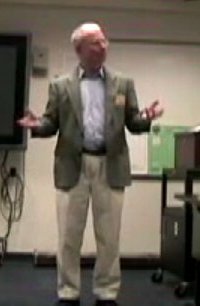 Have you ever been to a painfully bad seminar with audience members murmuring to each other…?
Have you ever been to a painfully bad seminar with audience members murmuring to each other…?- “What was that about?“
- “He was all over the place today.“
- “What was her point?“
The third Toastmasters speech project stresses the importance of clearly identifying your target objective, and then maintaining precise focus to achieve it. This article of the Toastmasters Speech Series examines the primary goals of this project, provides tips and techniques, and links to numerous sample speeches.
- The Ice Breaker
- Organize Your Speech
- Get to the Point
- How To Say It
- Your Body Speaks
- Vocal Variety
- Research Your Topic
- Get Comfortable with Visual Aids (coming next)
- Persuade with Power
- Inspire Your Audience
Why is This Speech Important?
Your aims for this speech project revolve around being focused and precise:- Determine your general purpose.
- Focus in on your specific purpose.
- Ensure that the entire speech maintains focus on your objective.
The Easy Part: Get to the Point
Your first task is to get to the point. Before you generate an outline or your first draft, be sure you know your purpose precisely. Make sure you can state it in a single simple sentence.A common pitfall is to choose topics which are too broad; remember that your time is limited. This can be challenging, but if you adopt the practice of determining your purpose before writing anything else, you will find this to be the easy part. (Read an earlier article about selecting a speech topic.)
The Harder Part: Stay Focused On the Point
The much harder part — and the part that many speakers struggle badly with — is staying focused on the point.No speaker intends to stray from their purpose; rather, it happens quite accidentally. Somewhere between getting to the point and writing the first draft, a collection of off topic elements are inserted into the speech.
- It might be an off-topic opening anecdote which is “too good not to share”.
- It might be some jaw-dropping statistics that are only remotely related to the topic.
- It might be the latest whiz-bang effect in PowerPoint that is glitzy, but content-empty.
 What I Did for Speech 3
What I Did for Speech 3
My speech topic was Raising a Reader. (I had just finished reading the excellent book from Jim Trelease titled The Read-Aloud Handbook. I highly recommend it for parents.)My original purpose was going to be to encourage the audience to be lifelong readers. I discovered a wealth of supporting evidence. However, I felt this topic was too broad.
Instead, I wrote my specific purpose: “After hearing this speech, the audience will be able to identify three reasons why reading aloud to a child is the best way to encourage them to be a lifelong reader.”
To support this purpose, my speech was organized as follows:
- Opening hook which illustrated the strong correlation between life success and a love of reading.
- Body of speech gave three benefits of reading aloud to children. Each was supported with simple facts and stories.
- Reason 1 – Increase the child’s listening vocabulary.
- Reason 2 – Gives the child a reading role model.
- Reason 3 – Associates reading with pleasure.
- Conclusion repeated the three benefits and emphasized that these benefits were easy to achieve.
Other Ideas for Toastmasters Speech 3
Below are three sample speeches delivered to satisfy Toastmasters speech project 3. All three are excellent examples which have a very clear purpose and strong focus on that purpose.For each of these three example speeches:
- What are the general and specific speech purposes?
(Do you agree with those that I have listed?) - What techniques were used to reinforce on these purposes?
- Was the speech focussed, or were there elements that did not belong?
 Example #1
Example #1
Lessons Learned in Napa by Emilie Staryak (video)- General purpose: To persuade.
- Specific purpose: To convince the audience to be open to new experiences by sharing lessons learned on a winetasting weekend.
- The speech opening was strong. It identified the four lessons:
- You don’t have to be a wine connoisseur to enjoy Napa.
- Wine tasters are not as hoity-toity as you might think.
- Your tastes can grow if you allow them to.
- Don’t just stop to taste the grapes.
- Focus: The lessons were supported with a series of personal stories. Every story related to these lessons. For example, the first lesson is supported by sharing that she and her husband were beer drinkers, but are now planning a second trip.
- Conclusion: The concluding sentence (“Who would have thought that two beer drinkers would be planning a second trip to Napa valley?“) reinforces the speech purpose.
 Example #2
Example #2
You’re Going to Wear THAT?!? by Arnie Buss (video)- General purpose: To inform
- Specific purpose: To provide advice in handing questions in a problem area.
- Introduction:
- Opens with a problematic question (the speech title) that many in the audience have probably experienced.
- Outlines 3 frameworks from which we answer questions
- our child self (the victim; taking blame)
- our parent self (passing judgment)
- our aware self.
- Demonstration #1: “Why do you only ever think of yourself?”
Excellent demonstration which gives three possible responses which correspond to the three frameworks. - Demonstration #2: “Does this dress make me look fat?”
This question generates humor (particularly since asked by a male audience member). However, it isn’t focused because the speaker has no “good” answer. - Demonstration #3: “Why don’t you ever take me anywhere?”
Another excellent demonstration applying the three frameworks. - Conclusion: A very solid conclusion which focuses on the specific purpose. He advises against using the first two frameworks, and then suggests using the third.
“It doesn’t enhance the relationship to make yourself wrong [1 is bad]. It doesn’t help enhance the relationship to make the other person wrong [2 is bad]. So, whenever you’re asked an entrapping question, never answer it until you find out why its being asked. Track the intent of the question. [3 is good] Don’t take the blame, track the pain. [memorable closing line]“
 Example #3
Example #3
Value Generated vs. Mark-Up Fund Raising by Paul Miller (video)- General purpose: To inform
- Specific purpose: Contrast two philosophies of fundraising, and suggest tools to evaluate fundraising strategies.
- Introduction: Clearly identified the specific purpose of the talk.
- Story #1 (Boy Scouts & popcorn): Excellent example of mark-up fund raising.
- Story #2 (Balloon dog): Excellent example of value generated fund raising.
- Numbers and Statistics: all focused on speech purpose e.g. “10 dollars leaves community versus 5 cents leaves community”
- Transition to the second half of the speech: Identifies 3 criteria for evaluating fund raising: (1) effect on individual (2) effect on community (3) effect on environment.
- More Stories: illustrate each of the three criteria
More Examples of Get to the Point
Here are a few more sample written and video speeches which may provide inspiration for you. For each speech, you might read (or watch) it first, and then check to see whether you agree with the general and specific purposes that I have listed for each speech. If you agree with me, then perhaps the speaker has achieved their purpose.Written Speech Examples
- The Devil’s Gardens by Les Aquino
General purpose: To inform
Specific purpose: To describe the relationship between the Schumanni ants and Hirsuta trees in the Amazon rain forest. - Channelled Authorship by Seamus McInerney
General purpose: To inform
Specific purpose: To describe the concept of channelled authorship.
(The last line of this speech is priceless.) - To Live Once by Edwin Vinas
I will not give general or specific purposes for this speech because the speaker has specified his purpose along with the speech text. - Break the Chain by Amit Bhatnagar
General purpose: To persuade
Specific purpose: To encourage the audience to stop forwarding chain email. - Blushful Moments by Felicity
General purpose: To persuade
Specific purpose: To encourage the audience to celebrate embarrassing moments. - You Put Your Left Arm In by Kane Baltetsch
General purpose: To entertain
Specific purpose: To share the history of the “Hokey Pokey” dance.
- The Ice Breaker
- Organize Your Speech
- Get to the Point
- How To Say It
- Your Body Speaks
- Vocal Variety
- Research Your Topic
- Get Comfortable with Visual Aids (coming next)
- Persuade with Power
- Inspire Your Audience
Video Speech Examples
- The Fair Tax by Alex Bein
General purpose: To persuade
Specific purpose: To convince the audience that a 23% national sales tax should replace individual income tax and several other taxes. - A Mystery of Matter by Chance Litton
General purpose: To inform
Specific purpose: To introduce the audience to the wave-particle phenomenon. - Have a Little Faith in Yourself by Karen Woodson
General purpose: To inform
Specific purpose: To highlight sources of low self-esteem and methods to improve self-esteem. - Double Your Happiness By Doing This by Vince
General purpose: To persuade
Specific purpose: To persuade the audience to overlook the temptation to pass judgment. - Appreciation by Heather
General purpose: To persuade
Specific purpose: To encourage the audience to appreciate life. - Dyslexics are Anything But Dumb! by Rosetta Ishag
General purpose: To inform
Specific purpose: To talk about the characteristics of dyslexia.
Next in the Toastmasters Speech Series
The next article in this series examines Toastmasters Speech 4: How to Say It.Source:
Toastmasters Speech 3: Get to the Point
http://sixminutes.dlugan.com/toastmasters-speech-3-get-to-the-point/
